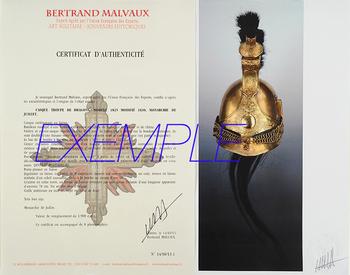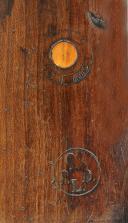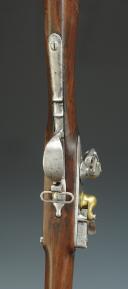
FUSIL D'INFANTERIE, modèle 1777 corrigé An IX, Restauration.
Sold out
INFANTRY RIFLE, corrected model 1777 Year IX, Restoration period.
Hexagonal then round barrel, length 1.135 m, with the breech tang 1.187 m, dated "G 1817", breech tang marked "M 77". Walnut stock, cheekpiece with partially faded acceptance stamp, and stamp "PLD" (property of the state). Flintlock mechanism engraved "Manuf Roy de Maubeuge". All fittings in steel. Nose cap, sling swivel, trigger guard held in place by springs. Conical-headed ramrod.
Overall length of the rifle: 1.515 m.
France.
Restoration.
Very good condition, repair on the stock near the cheek.
PAYMENT METHOD INFORMATION:
Firearms cannot be paid for via Paypal. This company rejects the trade of any type of weapons, including collectible firearms that are freely circulating and owned. Therefore, only checks, remote credit card payments (VPC), and IBAN transfers are accepted.
Disclaimer mandated by Google's ranking service:
This firearm is an antique collectible weapon that cannot be used, it is inactive, current cartridges are not suitable for this non-functioning firearm. The law of March 6, 2012 classifies firearms into 4 categories and regulates their acquisition and possession. Therefore, classification is essential. Decree No. 2013-700 of July 30, 2013 specifies the list of firearms specific to each category. The weapon presented falls under category D2, free possession, and can be purchased without any restriction, as it is inactive.
NOTE:
END OF A LEGEND "PDL" - THE STAMP ON THE NATIONAL GUARD'S WEAPONS
Extensive research has not yielded any evidence to attest to the reality of this motto "For the Right." So what is it? What is the National Guard? The National Guard was created during the Revolution. It is a militia tasked with maintaining order and upholding the law in troubled times. It is composed of all citizens aged 20 to 60. They are listed and classified for service, either in reserve or active guard duty. Initially, the National Guards were mostly bourgeois, as they were required to equip themselves at their own expense, and to be in the cavalry, one needed to own a horse. This role for the bourgeoisie was a means to maintain a form of power, to stand out from the rest of the citizenry.
The National Guards are distributed across all municipalities. They serve as the "Police" under the command of an officer, the mayor, and the prefect. During the Empire, the National Guard sometimes acted as a reserve army and was mobilized as needed during Napoleon's wars. After being disbanded by Charles X in 1827, it was reestablished by Louis Philippe in 1830. There would be a company in each municipality, comprising infantry, artillery, cavalry, and even firefighters. The National Guard was reactivated to quell disturbances and maintain calm throughout France after the July Revolution.
Marking of weapons with "PDL" in 1831
At the end of 1830, the minister aimed to organize the National Guards. He sought to regulate the troops and ordered the collection and registration of arms previously distributed during the July Revolution. A document from the archives of the city of Lyon dated August 10, 1830, attests to this. In January 1831, a ministerial circular was issued to mark the weapons that were distributed by the Ministry of War and therefore belonged to the state. These were to be stamped with "PDL" denoting "Property of the State," as shown in a document from January 20, 1831, from the prefecture to the Lyon archives. This stamping would be carried out using a punch that circulated from village to village in each canton. The marking would be done in the presence of National Guards assembled under the mayors and commanders. The punch would remain the property of the canton's capital. It was possible to continue these markings in the future. A report would be drawn up, signed by the Mayor, and sent to the prefecture.
It is noted that weapons belonging to municipalities, purchased at their own expense or by National Guards themselves, are not subject to this marking measure. The armament of the National Guards was quite diverse, including rifles, sabers, cartridge boxes, and other military-type equipment and uniforms often privately manufactured, differing from standard models. They were acquired by the National Guards themselves as well as by the municipalities. Lastly, there were standard firearms supplied to the municipalities as part of War Ministry allocations. These are the only category of equipment owned by the state that the ministry wished to mark to assert ownership and prevent the dispersion of weapons. An excerpt from the January 1831 circular reproduces the printed notice accompanying the punch given to the municipalities, outlining the method to be used for stamping rifles. The circular also mentions the creation, with the Interior Minister's approval, of an arms manual for the National Guards.
In 1848, after the February Revolution and the establishment of the Second Republic, a decree reactivated the National Guard in March. A front-page article in the "Courier de la Drome et de l'Ardèche" on October 29, 1848, No. 224, confirms that the same measures as in 1831 (still in force) were implemented with the census of National Guards and their weapons. The marking "PDL" on state-owned arms was reaffirmed. It was also stipulated that the conversion of National Guard's weapons to percussion by private gunsmiths was prohibited to prevent the proliferation of available calibers.
The stamp "PLD"
The mark in the wood created by stamping a blackened metal imprint with these three letters PDL was long interpreted as a motto "For the Right," which seems unfounded. These documents establish that it simply indicates "Property of the State." The rooster motif placed at the top recalls a national symbol revived by Louis Philippe upon his ascent to power in 1831. This stamp can be found on the stocks of pistols and standard rifles used by the National Guard, often being the 1816 or 1822 troop models and frequently the 1777 corrected model Year IX rifles. The War Ministry distributed outdated weapons to the National Guards, reserving the recent 1822 models for the military, followed by the 1822 T and Tbis models.
Evolution of the PDL markings
Military archive consultations have revealed further variations of this state identification mark. This stamping can sometimes be found on white arms such as swords or bayonets.
Hexagonal then round barrel, length 1.135 m, with the breech tang 1.187 m, dated "G 1817", breech tang marked "M 77". Walnut stock, cheekpiece with partially faded acceptance stamp, and stamp "PLD" (property of the state). Flintlock mechanism engraved "Manuf Roy de Maubeuge". All fittings in steel. Nose cap, sling swivel, trigger guard held in place by springs. Conical-headed ramrod.
Overall length of the rifle: 1.515 m.
France.
Restoration.
Very good condition, repair on the stock near the cheek.
PAYMENT METHOD INFORMATION:
Firearms cannot be paid for via Paypal. This company rejects the trade of any type of weapons, including collectible firearms that are freely circulating and owned. Therefore, only checks, remote credit card payments (VPC), and IBAN transfers are accepted.
Disclaimer mandated by Google's ranking service:
This firearm is an antique collectible weapon that cannot be used, it is inactive, current cartridges are not suitable for this non-functioning firearm. The law of March 6, 2012 classifies firearms into 4 categories and regulates their acquisition and possession. Therefore, classification is essential. Decree No. 2013-700 of July 30, 2013 specifies the list of firearms specific to each category. The weapon presented falls under category D2, free possession, and can be purchased without any restriction, as it is inactive.
NOTE:
END OF A LEGEND "PDL" - THE STAMP ON THE NATIONAL GUARD'S WEAPONS
Extensive research has not yielded any evidence to attest to the reality of this motto "For the Right." So what is it? What is the National Guard? The National Guard was created during the Revolution. It is a militia tasked with maintaining order and upholding the law in troubled times. It is composed of all citizens aged 20 to 60. They are listed and classified for service, either in reserve or active guard duty. Initially, the National Guards were mostly bourgeois, as they were required to equip themselves at their own expense, and to be in the cavalry, one needed to own a horse. This role for the bourgeoisie was a means to maintain a form of power, to stand out from the rest of the citizenry.
The National Guards are distributed across all municipalities. They serve as the "Police" under the command of an officer, the mayor, and the prefect. During the Empire, the National Guard sometimes acted as a reserve army and was mobilized as needed during Napoleon's wars. After being disbanded by Charles X in 1827, it was reestablished by Louis Philippe in 1830. There would be a company in each municipality, comprising infantry, artillery, cavalry, and even firefighters. The National Guard was reactivated to quell disturbances and maintain calm throughout France after the July Revolution.
Marking of weapons with "PDL" in 1831
At the end of 1830, the minister aimed to organize the National Guards. He sought to regulate the troops and ordered the collection and registration of arms previously distributed during the July Revolution. A document from the archives of the city of Lyon dated August 10, 1830, attests to this. In January 1831, a ministerial circular was issued to mark the weapons that were distributed by the Ministry of War and therefore belonged to the state. These were to be stamped with "PDL" denoting "Property of the State," as shown in a document from January 20, 1831, from the prefecture to the Lyon archives. This stamping would be carried out using a punch that circulated from village to village in each canton. The marking would be done in the presence of National Guards assembled under the mayors and commanders. The punch would remain the property of the canton's capital. It was possible to continue these markings in the future. A report would be drawn up, signed by the Mayor, and sent to the prefecture.
It is noted that weapons belonging to municipalities, purchased at their own expense or by National Guards themselves, are not subject to this marking measure. The armament of the National Guards was quite diverse, including rifles, sabers, cartridge boxes, and other military-type equipment and uniforms often privately manufactured, differing from standard models. They were acquired by the National Guards themselves as well as by the municipalities. Lastly, there were standard firearms supplied to the municipalities as part of War Ministry allocations. These are the only category of equipment owned by the state that the ministry wished to mark to assert ownership and prevent the dispersion of weapons. An excerpt from the January 1831 circular reproduces the printed notice accompanying the punch given to the municipalities, outlining the method to be used for stamping rifles. The circular also mentions the creation, with the Interior Minister's approval, of an arms manual for the National Guards.
In 1848, after the February Revolution and the establishment of the Second Republic, a decree reactivated the National Guard in March. A front-page article in the "Courier de la Drome et de l'Ardèche" on October 29, 1848, No. 224, confirms that the same measures as in 1831 (still in force) were implemented with the census of National Guards and their weapons. The marking "PDL" on state-owned arms was reaffirmed. It was also stipulated that the conversion of National Guard's weapons to percussion by private gunsmiths was prohibited to prevent the proliferation of available calibers.
The stamp "PLD"
The mark in the wood created by stamping a blackened metal imprint with these three letters PDL was long interpreted as a motto "For the Right," which seems unfounded. These documents establish that it simply indicates "Property of the State." The rooster motif placed at the top recalls a national symbol revived by Louis Philippe upon his ascent to power in 1831. This stamp can be found on the stocks of pistols and standard rifles used by the National Guard, often being the 1816 or 1822 troop models and frequently the 1777 corrected model Year IX rifles. The War Ministry distributed outdated weapons to the National Guards, reserving the recent 1822 models for the military, followed by the 1822 T and Tbis models.
Evolution of the PDL markings
Military archive consultations have revealed further variations of this state identification mark. This stamping can sometimes be found on white arms such as swords or bayonets.
Reference :
19555

Next update Friday, december 19 at 13:30 PM
FOR ALL PURCHASES, PAYMENT IN MULTIPLE CHECKS POSSIBLE
bertrand.malvaux@wanadoo.fr 06 07 75 74 63
SHIPPING COSTS
Shipping costs are calculated only once per order for one or more items, all shipments are sent via registered mail, as this is the only way to have proof of dispatch and receipt.
For parcels whose value cannot be insured by the Post, shipments are entrusted to DHL or Fedex with real value insured, the service is of high quality but the cost is higher.
RETURN POLICY
Items can be returned within 8 days of receipt. They must be returned by registered mail at the sender's expense, in their original packaging, and in their original condition.
AUTHENTICITY
The selection of items offered on this site allows me to guarantee the authenticity of each piece described here, all items offered are guaranteed to be period and authentic, unless otherwise noted or restricted in the description.
An authenticity certificate of the item including the description published on the site, the period, the sale price, accompanied by one or more color photographs is automatically provided for any item priced over 130 euros. Below this price, each certificate is charged 5 euros.
Only items sold by me are subject to an authenticity certificate, I do not provide any expert reports for items sold by third parties (colleagues or collectors).
FOR ALL PURCHASES, PAYMENT IN MULTIPLE CHECKS POSSIBLE
bertrand.malvaux@wanadoo.fr 06 07 75 74 63
An authenticity certificate of the item including the description published on the site, the period, the sale price, accompanied by one or more color photographs is automatically provided for any item priced over 130 euros. Below this price, each certificate is charged 5 euros.
Only items sold by me are subject to an authenticity certificate, I do not provide any expert reports for items sold by third parties (colleagues or collectors).








